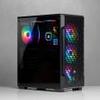Unboxing & First Impressions
Whilst I am sure the 220T is based on an already existing Corsair design, the looks of the case would probably lend to the belief that it is an entirely new design and base. We'll get straight to the tech specs, so see below (these are taken directly from the 220T's product page):
- Case Dimensions - 395mm x 210mm x 450mm
- Maximum GPU Length - 300mm
- Maximum PSU Length - 180mm
- Maximum CPU Cooler Height - 160mm
- Case Expansion (PCIe) Slots - 7
- Case Drive Bays - 2x 3.5'', 2x 2.5''
- Case Form Factor - ATX Mid-Tower
- Case Warranty - 2 Years
- Case Material - Steel, Tempered Glass
- Radiator Compatibility - 120, 140, 240, 280, 360mm
- Case Power Supply - ATX
- Weight - 6.5kg (14.3lb)
What jumps out at you there? To me, it's the combination of form factor (or, more accurately, the case's dimensions), significant radiator compatibility, and weight. Why? Well, I will explain, but first.
Anyway. Much of what I expected is here. The GPU length might be a little bit limiting on those wanting a 'fat' GPU and front-mounted radiator (which reduces clearance by a good 30-40mm), however, those running any regular dual slot/dual fan cards will be fine, I would suspect. I am also pleased to see a relatively hefty PSU allowance of 180mm, though do remember that any cable extending from the PSU's front will reduce this. However, given the modern efficiency of components and - therefore - the requirement for physically smaller PSUs with less overall output, and I suspect that 180mm is more than adequate for 95% of users.
So, back to earlier. I like the 220T's relatively diminutive form factor, whilst still managing to keep to the ATX specification. Good job, Corsair. In my view, the need for relatively compact ATX cases has never been higher. Sure, ITX and mATX are a thing, but they (especially the former) require special consideration with regard to cooling, airflow, connectivity, ease of working in, etc. For most, ATX is probably still the way to go.
I also really like how Corsair has been able to ensure maximum radiator compatibility with this product, allowing even 360mm radiators to be accommodated. This is, actually, really good news. Now, most people don't have cause to use such a large radiator, but it's good to know that you could if you wanted to. However, the 220T's ability to house such large radiators means you could, very easily, install a very high-end CPU such as Intel's 9900k, or AMD's R9 3900X without having to worry about thermals. Do keep in mind, though, that there are other factors to radiator compatibility than just the chassis being technically able to fit them. One of the biggest problems I have run into in this regard is actually the top mounting of a radiator in small(er) cases, where RAM and the motherboard's VRM heatsink(s) can often prevent the radiator slotting into place. Anyway, that aside, this case has quite significant flexibility when it comes to the 'range' of PC parts you could install inside it, and that - to me - is a major positive. Perhaps my only irritation is the relatively low maximum CPU cooler height, measuring in at 160mm. This effectively rules out the beefiest of air coolers if you hoped to pair them with something like an 8-core Intel or 12+ core AMD chip. Not that a smaller 180-200W TDP air cooler wouldn't work, but you'd probably be encouraged to use them at stock clocks.
Finally, we have the weight. Even given its relatively small size, the 220T weighs in at 6.5kg. For what is sure to be a fairly small case, I like the fact that it has some heft. Corsair offers a 2-year warranty with the case, which is probably about what is expected from an 80-100 USD/EUR chassis where the parts most likely to fail and die in that 2 year period are the 3x included SP120 case fans. Actually, that's a point, what about the fans Corsair have chosen to include? Corsair's now very long-lived line of SP120 fans come pre-installed in the 220T, all at the front (might, for the record, want to shift one of them to to the back slot if you don't plan to buy any more fans). See the specs below:
- Warranty - 2 years
- Fan Size - 120mm x 25mm
- Bearing Type - Hydraulic
- LED Colour - RGB
- Operating Voltage - 7v - 13.2v
- Speed (RPM) - 1400 (+/- 10%)
- Sound Level - 26 DbA)
- Static Pressure - 1.45mm H20
- Airflow - 52 CFM
I won't turn this into a fan vs. fan comparison between various vendors. Suffice to say that the SP120's are fairly standard pressure optimised fans that focus on pushing air at a higher pressure, rather than sheer volume. This makes them ideal for radiators or pulling/pushing air through more restricted spaces. Corsair, then, has chosen well. They certainly do offer higher end fans than the SP120's, however expecting them on a case that only costs sub 90 GBP is asking for a lot. In fact, given that the 3 pack of SP120 fans retails for just over 50 EUR on its own, you could argue that this case is exceptional value for money, providing you not only with the three fans, but also the iCUE Node controller. Moving on, then, we will now unbox the case and look through some of its features in more detail, along with plenty of photos to help you get a feel as to whether this chassis might be your next purchase.






